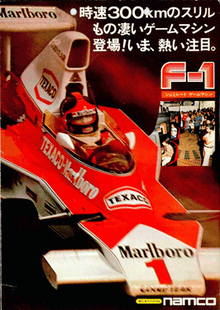F-1 (arcade game)
F-1 is a 1976 electro-mechanical racing arcade game developed and published by Namco. It was distributed by Atari, Inc. in the United States. The player uses a steering wheel to control a Formula One racer, which must avoid collision with other vehicles. The game uses a miniature diorama with small, plastic cars to represent the player's car and opponents on a physical, rotating track, while also featuring a projector system and lighting tricks to create the illusion of racing.
| F-1 | |
|---|---|
 Japanese promotional sales flyer | |
| Developer(s) | Namco |
| Publisher(s) |
|
| Designer(s) | Sho Osugi |
| Platform(s) | Arcade |
| Release | |
| Genre(s) | Racing |
| Mode(s) | Single-player |
| Cabinet | Electro-mechanical |
The game was designed by Namco engineer Sho Osugi, who worked on many of the company's earlier driving-themed mechanical games, and was made to be a smaller version of his earlier game Formula-X that could easily be placed into smaller stores and entertainment centers. The 1968 mechanical driving game Indy 500 by Kansai Seiki Seisakusho is also believed to be a source of inspiration for the game, likely due to Namco's strong business relationship with Kansai prior to development. Following its release, bootleg versions became rampant in Japanese arcade centers — to document evidence for impending legal action, Namco sent Pac-Man creator Toru Iwatani to investigate the factories producing them by taking photographs, however a home invasion instead caused these photos to become lost and unobtainable.
F-1 was widely successful upon release, being praised for its sense of thrill, responsive controls and attractive cabinet design. It is cited as the first game based on Formula One racing and one of Namco's first major arcade hits. It was followed by a sequel, F-1 Mach, a year later. A cabinet appears in the film Dawn of the Dead.
Gameplay
The player steers a car around a race track, trying to avoid all cars.[1]
Development and release
F-1 was designed by Namco engineer Sho Osugi, who worked on many of the company's earlier driving-themed mechanical arcade games.[2] The game is based on Osugi's previous racing games Racer (1973) and Formula-X (1975), the latter of which was only found in areas such as bowling allies due to its massive cabinet size — this lead to him producing a smaller version that could be fitted more easily into smaller stores and other entertainment centers.[2] This smaller version was also made to be a drastic improvement over the original, featuring more realistic lighting effects and a more effective projector system.[2] Kansai Seiki Seisakusho's 1968 driving game Indy 500 is also believed to have been a possible source of inspiration for the game, due to Namco's strong business relationship with them.[3]
F-1 was released by Namco in October 1976 in Japan. A month later in November it was licensed to Atari, Inc. for release in the United States, although Namco was credited on promotional material and the cabinet itself. Following its release, several bootleg versions of the game, referred to as "Zet Machines", began flowing into Japanese arcades — Namco's rival company Taito purchased a surplus amount of these machines for their arcade centers due to official units being unavailable.[3] Pac-Man creator Toru Iwatani was sent to investigate the factories producing the bootleg machines to take photographs as legal evidence, however a home invasion caused Iwatani to lose the photographs and leave them unobtainable.[3] A cease-and-desist order was then sent out by Namco in March 1977 which was swiftly ignored, following by a manufacturing ban being placed in August.[3]
Reception and legacy
F-1 was widely successful upon release.[4] It is cited as one of the first games based on Formula One racing[5] and one of Namco's first major arcade hits.[6] The December 25, 1976 issue of Cashbox magazine praised the game's responsive controls and impressive visual effects, alongside its attractive cabinet design.[7] Atari national sales manager Frank Ballouz found the game to be the "hottest" arcade game of the year, reacting to its positive response at the AMOA and IAAP tradeshows.[7]
A sequel, F-1 Mach, was released in 1977.[8]
In the 1978 film Dawn of the Dead, one of the characters is playing this game at the mall.[4]
References
- "F-1 - Arcade by Atari/Namco". Killer List of Videogames. Archived from the original on 6 February 2019. Retrieved 13 October 2019.
- Wong, Alistar (11 March 2019). "Chasing Down Memories Of Making Arcade Racers With Namco Veteran Sho Osugi". Siliconera. Archived from the original on 27 August 2019. Retrieved 13 October 2019.
- Iwatani, Toru (September 2005). Introduction to Pac-Man's Game Science. Enterbrain. p. 33.
- Barton, Matt (2017). Vintage Games 2.0: An Insider Look at the Most Influential Games of All Time. p. 73. Archived from the original on 13 October 2019. Retrieved 13 October 2019.
- Barker, Phil; Partridge, John (23 August 2017). "See the evolution of F1 in video games". Red Bull. Archived from the original on 13 October 2019. Retrieved 13 October 2019.
- L. Craddock, David (16 September 2019). "Arcade Perfect: How Pac-Man Was Ported To Consoles". Video Games Chronicle. Archived from the original on 18 September 2019. Retrieved 13 October 2019.
- Response Positive For Atari ‘F-1’ (PDF). Cashbox. 25 December 1976. p. 170. Retrieved 13 October 2019.
- http://bandainamcoent.co.jp/corporate/bnours/nours/vol27/pdf/27_10-11.pdf